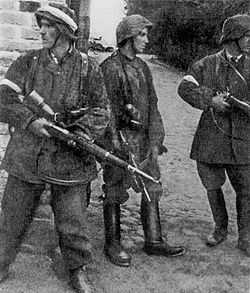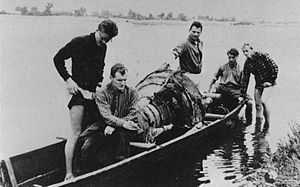Armia Krajowa and V-1 and V-2
| Part of a series on the |
Underground State |
|---|
 History of Poland 1939–1945 |
|
Authorities
|
|
Political organizations Major parties Minor parties
Opposition |
|
Military organizations Home Army (AK) Mostly integrated with Armed Resistance and Home Army Partially integrated with Armed Resistance and Home Army
Non-integrated but recognizing authority of Armed Resistance and Home Army Opposition |
|
Related topics
|
Aside from military operations, the Polish Armia Krajowa (Home Army) was also heavily involved in intelligence work, including work done with regard to the German "Wunderwaffe" - the V-1 flying bomb and the V-2 rocket. British intelligence received their first Polish report regarding the development of these weapons at Peenemünde in 1943.[1]
Early reports

By the summer of 1941 Home Army intelligence began receiving reports from its field units regarding some kind of secret tests being carried out by the Germans on the island of Usedom in the Baltic Sea. A special "Bureau" was formed within intelligence group "Lombard", charged with espionage inside the 3rd Reich and the Polish areas incorporated into it after 1939, to investigate the matter and to coordinate future actions. Specialized scientific expertise was provided to the group by the engineer Antoni Kocjan, "Korona", a renowned pre-war glider constructor. Furthermore, as part of their operations the "Bureau" managed to recruit an Austrian Anti-Nazi, Roman Traeger (T-As2), who was serving as an NCO in the Wehrmacht and was stationed on Usedom. Trager provided the AK with more detailed information regarding the "flying torpedoes" and pinpointed Peenemünde on Usedom as the site of the tests. The information obtained led to the first report from the AK to the British which was purportedly written by Jerzy Chmielewski, "Rafal", who was in charge of processing economic reports the "Lombard" group obtained.
Operation Most III
After V-2 flight testing began near the village of Blizna, south of Mielec (the first launch from there was on November 5, 1943), the AK had a unique opportunity to gather more information and to intercept parts of test rockets (most of which did not explode).
The AK quickly located the new testing ground at Blizna thanks to reports from local farmers and AK field units, who managed to obtain on their own pieces of the fired rockets, by arriving on the scene before German patrols. In late 1943 in cooperation with British intelligence, a plan was formed to make an attempt to capture a whole unexploded V-2 rocket and transport it to Britain.
At the time, opinion within British intelligence was divided. One group tended to believe the AK accounts and reports, while another was highly sceptical and argued that it was impossible to launch a rocket of the size reported by the AK using any known fuel. Then in early March 1944, British Intelligence Headquarters received a report of a Polish Underground worker (code name "Makary") who had crawled up to the Blizna railway line and saw on a flatcar heavily guarded by SS troops "an object which, though covered by a tarpaulin, bore every resemblance to a monstrous torpedo."[2] The Polish intelligence also informed the British about usage of liquid oxygen in a radio report from June 12, 1944. Some experts within both British and Polish intelligence communities quickly realized that learning the nature of the fuel utilized by the rockets was crucial, and hence, the need to obtain a working example.
From April 1944, numerous test rockets were falling near Sarnaki village, in the vicinity of the Bug River, south of Siemiatycze. The number of parts collected by the Polish intelligence increased. They were then analyzed by the Polish scientists in Warsaw. According to some reports, around May 20, 1944, a relatively undamaged V-2 rocket fell on the swampy bank of the Bug near Sarnaki and local Poles managed to hide it before German arrival. Subsequently, the rocket was dismantled and smuggled across Poland.[3] Operation Most III (Bridge III) secretly transported parts of the rocket out of Poland for analysis by British intelligence.
Impact on the course of the war
While the early knowledge on a rocket by AK was quite a feat in pure intelligence terms, it did not necessarily translate into significant results on the ground. On the other hand, the AK did alert the British as to the dangers posed by both missile designs, which led them to allocate more resources to bombing production and launching sites and thus lessened the eventual devastation caused by them. Also, the Operation Hydra bombing raid on Peenemünde, purportedly carried out on the basis of Home Army intelligence, did delay the V-2 by six to eight weeks.[4]
See also
References
- ↑ Garliński, Józef (1978). "Appendix II". Hitler's Last Weapons: The Underground War against the V1 and V2. New York: Times Books. p. 221.FOOTNOTE: Regarding the "widespread conviction" and Wojewódzki (pgs 18, 252) claim that :
Polish authorities in London received despatches and reports on the subject of Peenemünde as early as 1942,
the archives of the VIth Bureau that remained in Polish hands after the war and which, as of 1984, were to be found complete in the Polish Underground Movement (1939-45) Study Trust in London. Among them is "not a single document from 1942 concerning the V-1 and the V-2, nor has any been entered in the day-book of the VIth Bureau", and the lack of documentation regarding the claim was confirmed by Colonel Protasewicz and Lieutenant Colonel Bohdan Zielinski, head of the Bureau of Military Studies in the Home Army Intelligence in Warsaw 1943-44. - ↑ McGovern, James (1964). Crossbow and Overcast. New York: W. Morrow. p. 42.
- ↑ Wojewódzki, Michał (1984). Akcja V-1, V-2 (in Polish). Warsaw. ISBN 83-211-0521-1. FOOTNOTE: there are no material evidence, nor first-hand reports on capturing a whole rocket in May 1944, only several second-hand ones. An Intelligence report from June 12 mentions only parts of a rocket.
- ↑ Middlebrook, Martin (1982). The Peenemünde Raid: The Night of 17–18 August 1943. New York: Bobs-Merrill. p. 222.
- Churchill 'Memoirs of the Second World War'
- Eisenhower 'European Crusade'
- V-2 Ballistic Missile 1942 - 52